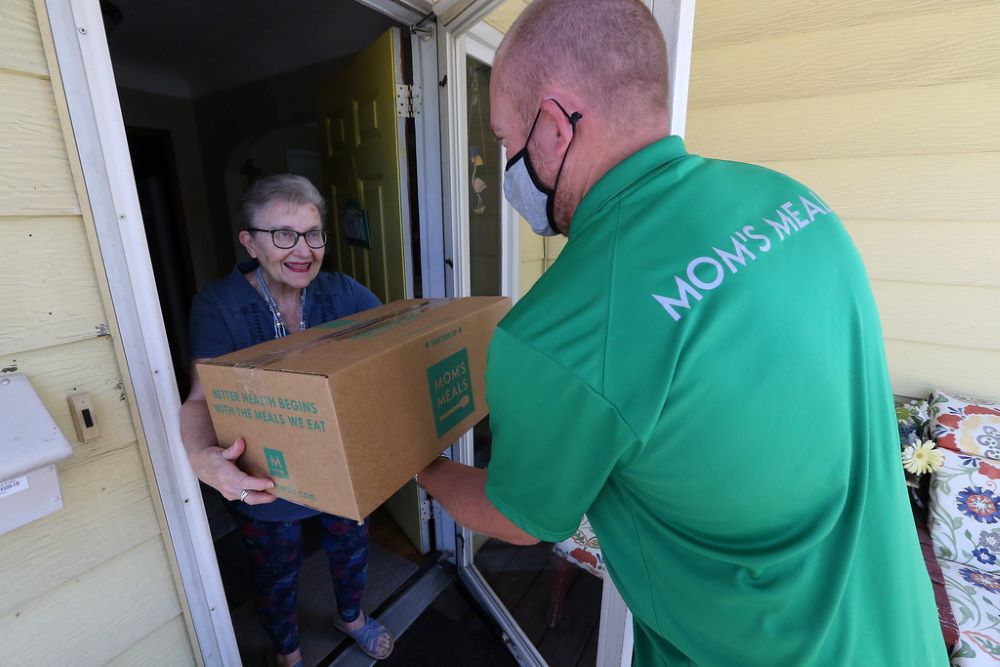Indeed, the 2020 has been like no one could have imagined! As December rolls on, Mom’s Meals® is taking some time to reflect on the year none of us will soon forget and look ahead to 2021. From the pandemic to predictions, let’s begin our review.
Looking back
No one can deny the impact of COVID-19, particularly given the startling number of Americans who are now facing food insecurity. It is estimated an additional 17 million people will be food insecure in 2020, raising the total to 54 million Americans.[1]
What legislation has been put in place this year to help vulnerable populations — including those who are food insecure, individuals with chronic conditions, and seniors — to get the nutrition they need to stay healthy? Consider some key initiatives:
- Beginning this year, the Balance Budget Act of 2018 (BBA) and subsequent CMS guidance allowed Medicare Advantage (MA) plans to offer special supplemental benefits for the chronically ill (SSBCI) that do not need to be primarily health-related. The benefits, which include home-delivered meals, transportation, and over-the-counter items, have been helping to address social determinants of health (SDOH).
- CMS announced changes allowing MA plans greater flexibility for nutrition benefits. CMS temporarily relaxed enforcement of a 2008 rule prohibiting mid-year benefit enhancements for MA organizations (73 Federal Register 43628) as long as the new enhancements are provided in connection with the COVID-19 outbreak, beneficial to enrollees, and provided uniformly to all similarly situated enrollees.
- On March 13, 2020, pursuant to section 1135(b) of the Social Security Act, the Department of Health and Human Services (HHS) invoked its authority to waive or modify certain requirements of title XVIII, XIX, and XXI of the Act. Section 1135 waivers give Medicaid health plans the flexibility to offer certain benefits, including home-delivered meals, to members even if plans had not filed for the benefit, or if there were provisions that would have otherwise restricted the plans from offering the benefit.
- CMS created a demonstration opportunity under the authority of section 1115(a) of the Social Security Act for states to test a variety of options — such as non-clinical services that can address food insecurity, among other SDOH — to deliver the most effective care to Medicaid beneficiaries as a result of the COVID-19 pandemic.
- The Nutrition Services Program, authorized under Title III of the Older Americans Act (OAA), received a total of $720 million in FY2020 supplemental funding for nutrition programs to respond to the COVID-19 pandemic. The program addresses food insecurity, promotes socialization, and promotes the health and well-being of older persons through nutrition and nutrition-related services. It also provides grants to state agencies on aging to support congregate and home-delivered meals for people aged 60 and older.
- The Families First Coronavirus Response Act (FFCRA) includes expansions in funding and authority measures to support various nutrition programs, including the Supplemental Nutrition Assistance Program (SNAP, formerly the Food Stamp program), food programs for schools, food programs targeting vulnerable communities, and food charities. Included in the bill is an additional $160 million to support home-delivered nutrition programs under the OAA.
- The Coronavirus Aid, Relief and Economic Security Act (CARES) Act contains health-related provisions focused on the outbreak in the U.S., including paid sick leave, insurance coverage for coronavirus testing, nutrition assistance, and other programs and efforts. It also includes support for the global response.
In addition to legislative initiatives, one major trend that continues to soar is telehealth. In 2019, 80 percent of insured employees had the option to use telehealth services, although fewer than five percent did.[2] COVID-19 truly set telehealth on a fast track, providing individuals with increased access to high-quality, efficient, cost-effective healthcare. In a Deloitte 2020 survey of U.S. health care consumers, the percentage of consumers using virtual visits increased from 15% to 19% from 2019 to the beginning of 2020 and then jumped to 28% in April 2020.[3]
In a study by Doximity (the largest community of healthcare professionals in the country), since the pandemic, the number of U.S. respondents reporting having at least one telehealth visit increased 57%. For those with a chronic illness, the increase was 77%. Doximity estimates telehealth will account for 20% of medical visits in 2020, representing $29.3 billion of medical services.[4] Forrester Research estimates virtual care visits will soar to more than 1 billion this year, including 900 million visits related to COVID-19.[5]
Facing forward
The year 2021 holds interesting predictions and great promise.
- Telehealth[6]
The demand for virtual care and in-home care is predicted to grow in 2021, according to Forrester Research. While in-person health care is expected to gradually increase, it is estimated telehealth will account for 440 million visits in 2021. - Medicaid[7]
- In a survey by the Kaiser Family Foundation (KFF) and Health Management Associates (HMA) of Medicaid directors in all 50 states and the District of Columbia, for FY 2021, nearly all states with projections (29 of 30) anticipate total Medicaid spending rates will continue to increase over FY 2020 spending rates, primarily due to increases in enrollment.
- Since COVID-19, Medicaid enrollment increased 6.2% to nearly 4 million new recipients, according to CMS.
- Medicare Advantage[8],[9]
- MA enrollment is projected to increase from 24.4 million to 26.9 million beneficiaries in 2021. Patients with end-stage renal disease (ESRD) will be able to enroll in MA plans under the 21st Century Cures Act requirements, giving them more affordable coverage choices. Beginning in January, beneficiaries with diabetes will have access to more than 1,600 MA and Part D prescription drug plans. All plans will offer insulin for a co-pay of $35 per month.
- CMS finalized a modification to its Special Supplemental Benefits for the Chronically Ill (SSBCI) guidance. For the contract year 2021, CMS is loosening restrictions around what chronic conditions a patient must have in order to be eligible under SSBCI. Medicare plans will be able to target other chronic conditions that may not meet the definition outlined in the Medicare Managed Care Manual.
- Based on flexibilities the Trump Administration provided Medicare Advantage and Part D plans over the last three years, beneficiaries will have more plan choices with new types of extra benefits not typically covered in traditional Medicare. Highlights include:
- About 920 plans reaching 4.3 million beneficiaries will offer non-primarily health-related benefits tailored to people with chronic conditions that may help them better manage their disease(s). Examples include pest control, home cleaning services, home meal delivery, and transportation for non-medical reasons.
- More than 440 MA plans will be participating in the 2021 Medicare Advantage Value-Based Insurance Design Model, with over 1.6 million beneficiaries projected to receive additional benefits, such as healthy foods and meals, transportation support, reduced cost-sharing, and rewards and incentives aligned with Part D drugs.
- CMS implemented measures to improve access to telehealth services for Medicare beneficiaries. Enrollees can access additional benefits not provided under Medicare-Fee-for-Service, which allows them to receive health care services from home. MA plans can also cover a wider range of telehealth services, including specialists for primary care, psychiatry, cardiology, and dermatology.
This year has brought many uncertainties on all fronts. As we transition to tomorrow, we believe we’ll continue to see new legislation and initiatives that focus on ensuring the health of our most vulnerable populations.
[1]https://c8y.doxcdn.com/image/upload/Press%20Blog/Research%20Reports/2020-state-telemedicine-report.pdf
[2] https://go.forrester.com/press-newsroom/us-virtual-care-visits-to-soar-to-more-than-1-billion/
[3] https://www.bain.com/insights/why-telehealth-will-outlast-the-pandemic/
[4] https://www2.deloitte.com/us/en/insights/industry/health-care/consumer-health-trends.html
[5] https://www.feedingamerica.org/sites/default/files/2020-05/Brief_Local%20Impact_5.19.2020.pdf
[6] https://www.managedhealthcareexecutive.com/view/forrester-s-2021-prediction-watch-out-in-person-care-the-telehealth-surge-will-continue
[7] https://www.kff.org/medicaid/issue-brief/early-look-at-medicaid-spending-and-enrollment-trends-amid-covid-19/
[8] https://www.cms.gov/newsroom/press-releases/trump-administration-announces-historically-low-medicare-advantage-premiums-and-new-payment-model
[9] https://www.cms.gov/newsroom/fact-sheets/contract-year-2021-medicare-advantage-and-part-d-final-rule-cms-4190-f1-fact-sheet



